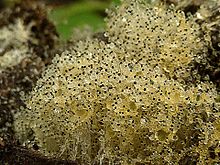Pilobolus
| Pilobolus | |
|---|---|
 |
|
| Pilobolus spp. | |
| Scientific classification | |
| Kingdom: | Fungi |
| Division: | Zygomycota |
| Class: | Mucoromycotina |
| Order: | Mucorales |
| Family: | Pilobolaceae |
| Genus: |
Pilobolus Tode (1784) |
| Type species | |
|
Pilobolus crystallinus L.Klein |
|
| Species | |
|
P. crystallinus |
|
| Synonyms | |
|
Hydrogera F.H.Wigg. ex Kuntze (1891) |
|
P. crystallinus
P. kleinii
P. longipes
P. sphaerosporus
P. umbonatus
P. roridus
Hydrogera F.H.Wigg. ex Kuntze (1891)
Pycnopodium Corda (1842)
Pilobolus is a genus of fungi that commonly grows on herbivore dung.
The life cycle of Pilobolus begins with a black sporangium that has been discharged onto a plant substrate such as grass. A herbivorous animal such as a horse then eats the substrate, unknowingly consuming the sporangium as well. The Pilobolus sporangium survives the passage through the gastrointestinal tract without germinating, and emerges with the excrement. Once outside its host, spores within the sporangium germinate and grow as a mycelium within the excrement, where it is a primary colonizer. Later, the fungus fruits to produce more spores.
The asexual fruiting structure (the sporangiophore) of Pilobolus species is unique. It consists of a transparent stalk which rises above the excrement to end in a balloon-like subsporangial vesicle. On top of this, a single, black sporangium develops. The sporangiophore has the remarkable ability of orienting itself to point directly towards a light source. The subsporangial vesicle acts as a lens, focusing light via carotenoid pigments deposited near the base of the vesicle. The developing sporangiophore grows such that the maturing sporangium is aimed directly at the light.
...
Wikipedia
